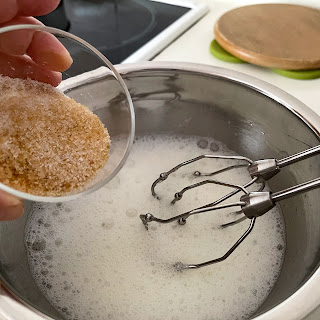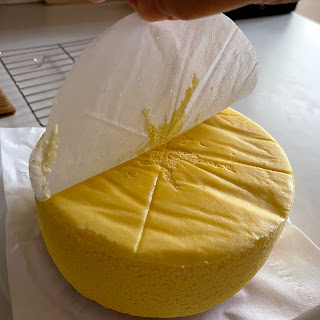I never knew soy milk and butter could create such a nice, mellow sweet flavour sponge cake until I baked it. My initial intention was to add vanilla extract to it, however, I accidentally spilled the mixture, and smelled the un-paired aroma of soy milk and vanilla. After leaving out vanilla from the ingredient list, I baked an wonderfully aromatic sponge cake. Give this recipe a try, I am sure you would love it 😋😍
Yield: 1 round cake
Pan size: 6x3" round pan
Baking temperature: Preheated oven to 170℃ switching on only the upper heating element, bake at lower rack at 170℃ for 40 minutes. Reduce temperature to 150℃ switching on both upper and lower heating coils, and bake for 20 minutes.
Ingredients
All ingredients in room temperature
Using 55g Omega 3&6 eggs
40g unsalted butter
60g top/cake flour
3g milk powder
1/8 tsp low-sodium salt
30g sweetened soy milk/milk
10g condensed milk
3 egg yolks
3 egg whites
slightly less than 1/4 tsp cream of tartar
25g fine sugar
20g raw sugar/fine sugar
Directions
1. Line an 6" round cake pan with parchment paper at the base. Need not grease the wall of the pan. Place a grid iron at the base of a 20cm square pan. Set aside.
I bought the grid iron from Daiso.
2. Combine soy milk, and condensed milk in a small glass. Set aside to thaw to room temperature.
3. Mix top flour, milk powder, and salt in a small bowl. Stir to loosen and mix. Set aside.
4. Warm butter at low temperature till reaching about 69 to 72℃ or small bubbles start to form at the bottom of the melted butter.
Pour the top/cake flour mixture from Step 3 into the warm butter, mix briefly using a silicone spatula, and remove from the stove. Continue to fold till it becomes a smooth paste.
Ensure all the butter has been well incorporated with the flour, or else the "loose" butter will burst the bubbles of the meringue later.
5. Combine in the egg yolks, one at a time.
mix into a smooth batter. Set aside.
6. Beat egg whites in a clean, dry and grease-free bowl, till frothy. Add in first batch of the fine and raw sugar, and cream of tartar mixture. Continue to beat the egg whites at high speed. Slowly add in the remaining sugar mixture in two batches.
Fresh eggs will give a smooth and glossy meringue, while the egg whites of the "aged" eggs will be more watery, so it's difficult to achieve nice smooth meringue.
Stop beating after the meringue has achieved almost stiff peak stage.
7. Transfer about 1/4 of the meringue to combine with the yolk batter from Step 5.
Pour back the yolk batter to mix with the remaining meringue into a smooth batter.
8. Pour the batter into the prepared cake pan.
Bang the cake pan against the work top to level the batter and to get rid of trapped air bubbles.
Place the cake pan into the 20cm square pan, and fill the square pan with about 1cm deep of hot water.
9. Bake at lower rack of a preheated oven at 170℃, turning on only the upper heating element, for about 40 minutes.
After the 40 minutes heating, reduce the temperature to 150℃, turning on both the upper and lower heating elements, for about 20 minutes.
10. Remove the cake from the oven.
Let the cake cool down for about 20 to 25 minutes in the pan.
When the cake starts to pull away from the wall of the pan, jiggle to loosen the cake, and turn it out to a cooling rack
You may want to dry the cake in a warm oven for about 15 minutes.


































Hi, my oven only have both uppee n bottom heating function, so what temperature n timing do I set? Thank u
ReplyDelete